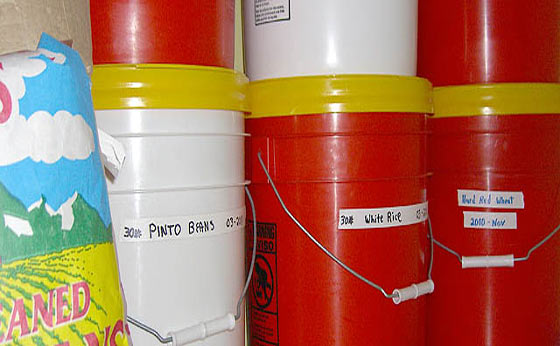4 Things That Affect Your Food Storage

The shelf life of your food storage is affected by many things, perhaps most important are temperature, moisture, atmosphere, and containment.
Here’s more detail…
Food Storage Temperature
Temperature greatly affects food storage life.
Based on the Q10 temperature coefficient formula ‘Rule of 10’,
For every 10 degrees-C, shelf life will halve (hotter) or double (cooler).
Translated to degrees-F as follows: For every 18 degrees-F, shelf life will halve (hotter) or double (cooler).
Food Shelf Live vs. Temperature | Examples
Generally, stated food shelf life is referenced to room temperature, 22°C (72°F).
So using the formula above, you could guesstimate the following approximate relationship examples:
90°F Average Storage Temperature
– half the stated shelf life
54°F Average Storage Temperature
– double the stated shelf life
Basically when your food storage location is above ‘room temperature’, the shelf life decreases. When it’s below room temp., it increases.
From this we learn how important it is to store your long-term food supplies in the coolest place possible!
Attics = bad
Basement = better
Temperature vs. Food Storage Shelf Life
Food Storage | Moisture Content
1. The moisture content of the food itself (some exceptions including ‘canned’ or ‘home canned’, or other sealed processing).
2. Moisture in the storage environment.
For long-term storage of grains, dehydrated foods, and other ‘dry foods’, drier is better. The drier the food the longer the shelf life – to an extent.
For example, grains should maintain a moisture content of 10% or less. Commercially dried foods easily achieve these levels.
Be aware of the likelihood that typical home dehydrated foods might not result in the same moisture levels as commercially dried foods. Therefore they may not last as long. As a rule of thumb, dried foods with 10% or less moisture will snap easily and are very brittle.
Unless the food is packaged in air-tight containment, the moisture from the environment will work it’s way in over time and reduce it’s shelf life.
Atmosphere within the Food Storage Containment
Earth’s atmosphere contains about 78% nitrogen and 21% oxygen. Oxygen oxidizes many of the compounds in food and reduces it’s shelf life over time.
Bacteria, one of several agents which make food go rancid also needs oxygen to grow.
For maximum shelf life, foods should be stored in an oxygen free environment.
Oxygen absorbers dropped into a sealed container or a Mylar bag is common practice for long-term food storage. When oxygen within the sealed container is absorbed, what remains is 99% pure nitrogen in a partial vacuum – a good atmospheric condition for food storage.
How to Seal a Mylar Bag in a 5-Gallon Bucket
What Size Oxygen Absorber To Use?
Food Storage Container | Sealed
To get the best storage life for most food products, the product container must have a hermetic (air tight) seal. Ideally opaque (non see-through) or stored away from sunlight.
Common sealing methods/containers include vacuum sealed bags (Food Saver), sealed Mylar bags, commercially sealed cans or jars, home-canned, sealed food storage buckets/pails.
NESCO Food Vacuum Sealing System
One issue when storing foods for long-term is that of bugs and rodents. Some containers are better than others at keeping them out. Just be aware.
Tip: To minimize a bug infestation problem, before packaging/storing dry foods/ grains for the long-term, freeze the product in a chest freezer for ~ 48 hours. This will kill bugs and larvae/eggs if they exist. Make sure it dries out for several days after you take it out of the freezer.
Continue reading: Food Dehydrator Basics
